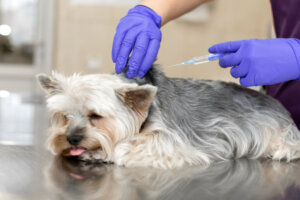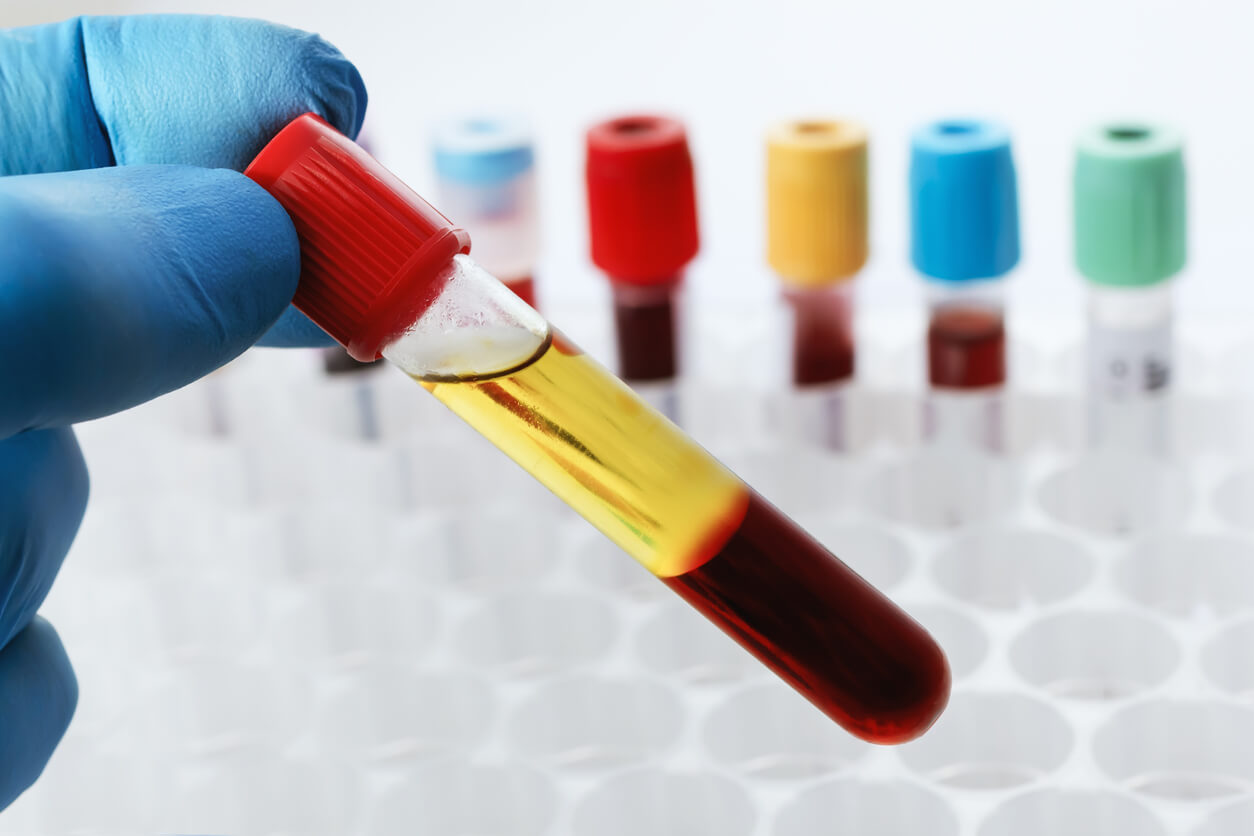Platelet-Rich Plasma (PRP): Uses and Benefits in Pets


Written and verified by the veterinarian and zootechnician Sebastian Ramirez Ocampo
Based on the principle of accelerating healing processes and, at the same time, recovering the function of the affected tissue, platelet-rich plasma (PRP) has been widely used in the treatment of intermuscular, ocular, and dermatological pathologies in pets.
Due to its practicality and low production cost, this substance is presented as an acceptable adjuvant in the cellular regeneration of animals who are having difficulties with tissue recovery. Discover in the following content what PRP is and how it’s used in veterinary circles.
What is platelet-rich plasma?
Platelet-rich plasma (PRP) is a biological material obtained by separating the liquid and cellular components of blood, usually by centrifugation techniques. This procedure allows the blood to be divided into three layers.
- A lower one composed of red blood cells
- A middle one made up of white blood cells and platelets
- An upper one composed of blood plasma
Thanks to this process, it’s possible to obtain blood plasma with high platelet concentrations, even five times higher than those found in blood under normal conditions. It should be noted that the portions used in medical treatment are the last two layers.
Its importance and effectiveness lies in the functions that each of its components fulfills in the body. On the one hand, white blood cells or leukocytes help to mediate the inflammatory response. They’re also involved in the defense against infectious agents and in the process of wound repair and healing.
On the other hand, platelets play a major role in the process known as hemostasis. They act as a plug in cases of bleeding or injury by forming clots and releasing substances that promote tissue repair. In addition, they secrete growth factors, which are essential in body tissue recovery.
In this sense, PRP doesn’t only have direct effects on the normal healing process, but also acts as a stimulant for tissue regeneration in a global way. Consequently, the aim isn’t just for the cells to heal, but for them to become functional again.

Growth factors
Growth factors (GF) are molecules of protein origin whose main mission is to regulate cell migration, proliferation, differentiation, and metabolism. Their specific functions include stimulating the movement of reparative cells to sites of injury and increasing protein synthesis for cell regeneration.
In addition, GFs are involved in the processes of new blood vessel formation and collagen production during the repair of damaged tissue. They can be classified according to their specificity or field of action as follows:
- Platelet-derived growth factor (PDGF): This promotes the formation of blood vessels and facilitates the formation of type I collagen.
- Transforming growth factor-beta (TGF-beta): This stimulates the proliferation and differentiation of mesenchymal cells and boosts collagen synthesis by osteoblasts.
- Fibroblast growth factor (FGF): This participates in the proliferation of osteoblasts and fibroblasts, cells that are indispensable in the repair of bone tissue.
- Vascular endothelial growth factor (VEGF): This promotes the proliferation of endothelial cells and generates an increase in the permeability of blood vessels.
Platelet-rich plasma in pets
The use of platelet-rich plasma has gained some popularity in recent years as it’s a minimally invasive and affordable treatment. This is because the blood is taken from the same animal to which it’s to be applied. Numerous investigations have used PRP as an adjuvant in the management of various pathologies of traumatic or degenerative origin in pets.
Use in dogs
In the case of dogs, a study published in the journal In Vivo obtained positive results when using PRP as an adjuvant in the recovery of fractures of long bones such as the radius or tibia in fractured canines.
Likewise, according to the article “Platelet-rich plasma therapy in dogs with bilateral hip osteoarthritis“, the use of PRP can help decrease pain and loss of function in dogs suffering from hip dysplasia or osteoarthritis.
In addition, a recent article in the journal Animals suggests PRP as an alternative treatment to epidural prednisolone in dogs with lumbosacral stenosis or cauda equina disease. Although most research is focused on osteoarticular recovery and regeneration, its applications aren’t only limited to this field.

A meta-analysis developed in Italy and published in the scientific journal PLoS One, where about 18 studies were analyzed, found that animals with skin wounds treated with PRP had a better recovery than those not treated with this preparation.
Finally, platelet-rich plasma has also been used in dogs for the treatment of corneal ulcers and keratoconjunctivitis sicca, as well as in skin burns, skin ulcers, tendinopathies, and cartilage diseases.
Management in cats
In cats, PRP has been evaluated to a greater extent in ocular pathologies. A study in the journal Frontiers in Veterinary Science reported that platelet-rich plasma is effective for the treatment of superficial and deep corneal ulcers in affected cats. In addition, another article in the journal Animals successfully established PRP-based therapy in felines with exposed skin wounds.
How is PRP applied to animals?
Generally, when PRP is used as an adjuvant in the treatment of fractures, it’s applied during the surgical procedure. As it’s a liquid compound, it can be injected directly into the fractured bone union, immediately stimulating bone regeneration.
In the case of skin lesions, platelet-rich plasma is applied by means of dermal micropunctures around the affected area. Finally, in eye problems, it’s used in the form of eye drops, which can be administered directly to the treated eye.
The future of platelet-rich plasma
More studies are still needed to determine the safety and effectiveness of platelet-rich plasma in pets. However, due to its biological and autologous origin, PRP is a possible option in processes that are difficult to resolve by conventional treatments. However, it’s advisable to consult a veterinarian before making a decision.
Based on the principle of accelerating healing processes and, at the same time, recovering the function of the affected tissue, platelet-rich plasma (PRP) has been widely used in the treatment of intermuscular, ocular, and dermatological pathologies in pets.
Due to its practicality and low production cost, this substance is presented as an acceptable adjuvant in the cellular regeneration of animals who are having difficulties with tissue recovery. Discover in the following content what PRP is and how it’s used in veterinary circles.
What is platelet-rich plasma?
Platelet-rich plasma (PRP) is a biological material obtained by separating the liquid and cellular components of blood, usually by centrifugation techniques. This procedure allows the blood to be divided into three layers.
- A lower one composed of red blood cells
- A middle one made up of white blood cells and platelets
- An upper one composed of blood plasma
Thanks to this process, it’s possible to obtain blood plasma with high platelet concentrations, even five times higher than those found in blood under normal conditions. It should be noted that the portions used in medical treatment are the last two layers.
Its importance and effectiveness lies in the functions that each of its components fulfills in the body. On the one hand, white blood cells or leukocytes help to mediate the inflammatory response. They’re also involved in the defense against infectious agents and in the process of wound repair and healing.
On the other hand, platelets play a major role in the process known as hemostasis. They act as a plug in cases of bleeding or injury by forming clots and releasing substances that promote tissue repair. In addition, they secrete growth factors, which are essential in body tissue recovery.
In this sense, PRP doesn’t only have direct effects on the normal healing process, but also acts as a stimulant for tissue regeneration in a global way. Consequently, the aim isn’t just for the cells to heal, but for them to become functional again.

Growth factors
Growth factors (GF) are molecules of protein origin whose main mission is to regulate cell migration, proliferation, differentiation, and metabolism. Their specific functions include stimulating the movement of reparative cells to sites of injury and increasing protein synthesis for cell regeneration.
In addition, GFs are involved in the processes of new blood vessel formation and collagen production during the repair of damaged tissue. They can be classified according to their specificity or field of action as follows:
- Platelet-derived growth factor (PDGF): This promotes the formation of blood vessels and facilitates the formation of type I collagen.
- Transforming growth factor-beta (TGF-beta): This stimulates the proliferation and differentiation of mesenchymal cells and boosts collagen synthesis by osteoblasts.
- Fibroblast growth factor (FGF): This participates in the proliferation of osteoblasts and fibroblasts, cells that are indispensable in the repair of bone tissue.
- Vascular endothelial growth factor (VEGF): This promotes the proliferation of endothelial cells and generates an increase in the permeability of blood vessels.
Platelet-rich plasma in pets
The use of platelet-rich plasma has gained some popularity in recent years as it’s a minimally invasive and affordable treatment. This is because the blood is taken from the same animal to which it’s to be applied. Numerous investigations have used PRP as an adjuvant in the management of various pathologies of traumatic or degenerative origin in pets.
Use in dogs
In the case of dogs, a study published in the journal In Vivo obtained positive results when using PRP as an adjuvant in the recovery of fractures of long bones such as the radius or tibia in fractured canines.
Likewise, according to the article “Platelet-rich plasma therapy in dogs with bilateral hip osteoarthritis“, the use of PRP can help decrease pain and loss of function in dogs suffering from hip dysplasia or osteoarthritis.
In addition, a recent article in the journal Animals suggests PRP as an alternative treatment to epidural prednisolone in dogs with lumbosacral stenosis or cauda equina disease. Although most research is focused on osteoarticular recovery and regeneration, its applications aren’t only limited to this field.

A meta-analysis developed in Italy and published in the scientific journal PLoS One, where about 18 studies were analyzed, found that animals with skin wounds treated with PRP had a better recovery than those not treated with this preparation.
Finally, platelet-rich plasma has also been used in dogs for the treatment of corneal ulcers and keratoconjunctivitis sicca, as well as in skin burns, skin ulcers, tendinopathies, and cartilage diseases.
Management in cats
In cats, PRP has been evaluated to a greater extent in ocular pathologies. A study in the journal Frontiers in Veterinary Science reported that platelet-rich plasma is effective for the treatment of superficial and deep corneal ulcers in affected cats. In addition, another article in the journal Animals successfully established PRP-based therapy in felines with exposed skin wounds.
How is PRP applied to animals?
Generally, when PRP is used as an adjuvant in the treatment of fractures, it’s applied during the surgical procedure. As it’s a liquid compound, it can be injected directly into the fractured bone union, immediately stimulating bone regeneration.
In the case of skin lesions, platelet-rich plasma is applied by means of dermal micropunctures around the affected area. Finally, in eye problems, it’s used in the form of eye drops, which can be administered directly to the treated eye.
The future of platelet-rich plasma
More studies are still needed to determine the safety and effectiveness of platelet-rich plasma in pets. However, due to its biological and autologous origin, PRP is a possible option in processes that are difficult to resolve by conventional treatments. However, it’s advisable to consult a veterinarian before making a decision.
All cited sources were thoroughly reviewed by our team to ensure their quality, reliability, currency, and validity. The bibliography of this article was considered reliable and of academic or scientific accuracy.
- Alves, J. C., Santos, A., & Jorge, P. (2021). Platelet-rich plasma therapy in dogs with bilateral hip osteoarthritis. BMC veterinary research, 17(1), 207. https://doi.org/10.1186/s12917-021-02913-x
- Angelou, V., Psalla, D., Dovas, C. I., Kazakos, G. M., Marouda, C., Chatzimisios, K., Kyrana, Z., Moutou, E., Karayannopoulou, M., & Papazoglou, L. G. (2022). Locally Injected Autologous Platelet-Rich Plasma Improves Cutaneous Wound Healing in Cats. Animals : an open access journal from MDPI, 12(15), 1993. https://doi.org/10.3390/ani12151993
- Farghali, H. A., AbdElKader, N. A., AbuBakr, H. O., Ramadan, E. S., Khattab, M. S., Salem, N. Y., & Emam, I. A. (2021). Corneal Ulcer in Dogs and Cats: Novel Clinical Application of Regenerative Therapy Using Subconjunctival Injection of Autologous Platelet-Rich Plasma. Frontiers in veterinary science, 8, 641265. https://doi.org/10.3389/fvets.2021.641265
- Hernández-Guerra, Á. M., Carrillo, J. M., Sopena, J. J., Vilar, J. M., Peláez, P., Cuervo, B., Santana, A., & Rubio, M. (2021). Platelet-Rich Plasma for the Treatment of Degenerative Lumbosacral Stenosis: A Study with Retired Working Dogs. Animals : an open access journal from MDPI, 11(10), 2965. https://doi.org/10.3390/ani11102965
- Iacopetti, I., Patruno, M., Melotti, L., Martinello, T., Bedin, S., Badon, T., Righetto, E. M., & Perazzi, A. (2020). Autologous Platelet-Rich Plasma Enhances the Healing of Large Cutaneous Wounds in Dogs. Frontiers in veterinary science, 7, 575449. https://doi.org/10.3389/fvets.2020.575449
- Moreno, Raquel, Gaspar Carreño, Marisa, Jiménez Torres, José, Alonso Herreros, José María, Villimar, Ana, & López Sánchez, Piedad. (2015). Técnicas de obtención del plasma rico en plaquetas y su empleo en terapéutica osteoinductora. Farmacia Hospitalaria, 39(3), 130-136. https://dx.doi.org/10.7399/fh.2015.39.3.7998
- Sharun, K., Jambagi, K., Dhama, K., Kumar, R., Pawde, A. M., & Amarpal (2021). Therapeutic Potential of Platelet-Rich Plasma in Canine Medicine. Archives of Razi Institute, 76(4), 721–730. https://doi.org/10.22092/ari.2021.355953.1749
- Szponder, T., Wessely-Szponder, J., Sobczyńska-Rak, A., Żylińska, B., Radzki, R. P., & Polkowska, I. (2018). Application of Platelet-rich Plasma and Tricalcium Phosphate in the Treatment of Comminuted Fractures in Animals. In vivo (Athens, Greece), 32(6), 1449–1455. https://doi.org/10.21873/invivo.11398
- Tambella, A. M., Attili, A. R., Dupré, G., Cantalamessa, A., Martin, S., Cuteri, V., Marcazzan, S., & Del Fabbro, M. (2018). Platelet-rich plasma to treat experimentally-induced skin wounds in animals: A systematic review and meta-analysis. PloS one, 13(1), e0191093. https://doi.org/10.1371/journal.pone.0191093
- Rodríguez Flores, Jordi, Palomar Gallego, María Angustias, & Torres García-Denche, Jesús. (2012). Plasma rico en plaquetas: fundamentos biológicos y aplicaciones en cirugía maxilofacial y estética facial. Revista Española de Cirugía Oral y Maxilofacial, 34(1), 8-17. Recuperado en 26 de abril de 2023, de http://scielo.isciii.es/scielo.php?script=sci_arttext&pid=S1130-05582012000100002&lng=es&tlng=es.
- Cuadros-Corredor, Yesid L, Siabato-Moreno, Juan C, & Roque-Rodriguez, Anita. (2021). Uso de los factores de crecimiento presentes en el plasma rico en plaquetas como un tratamiento alternativo de lesiones músculo esqueléticas en animales. ORINOQUIA, 25(1), 47-64. Epub November 03, 2021.https://doi.org/10.22579/20112629.655
This text is provided for informational purposes only and does not replace consultation with a professional. If in doubt, consult your specialist.








